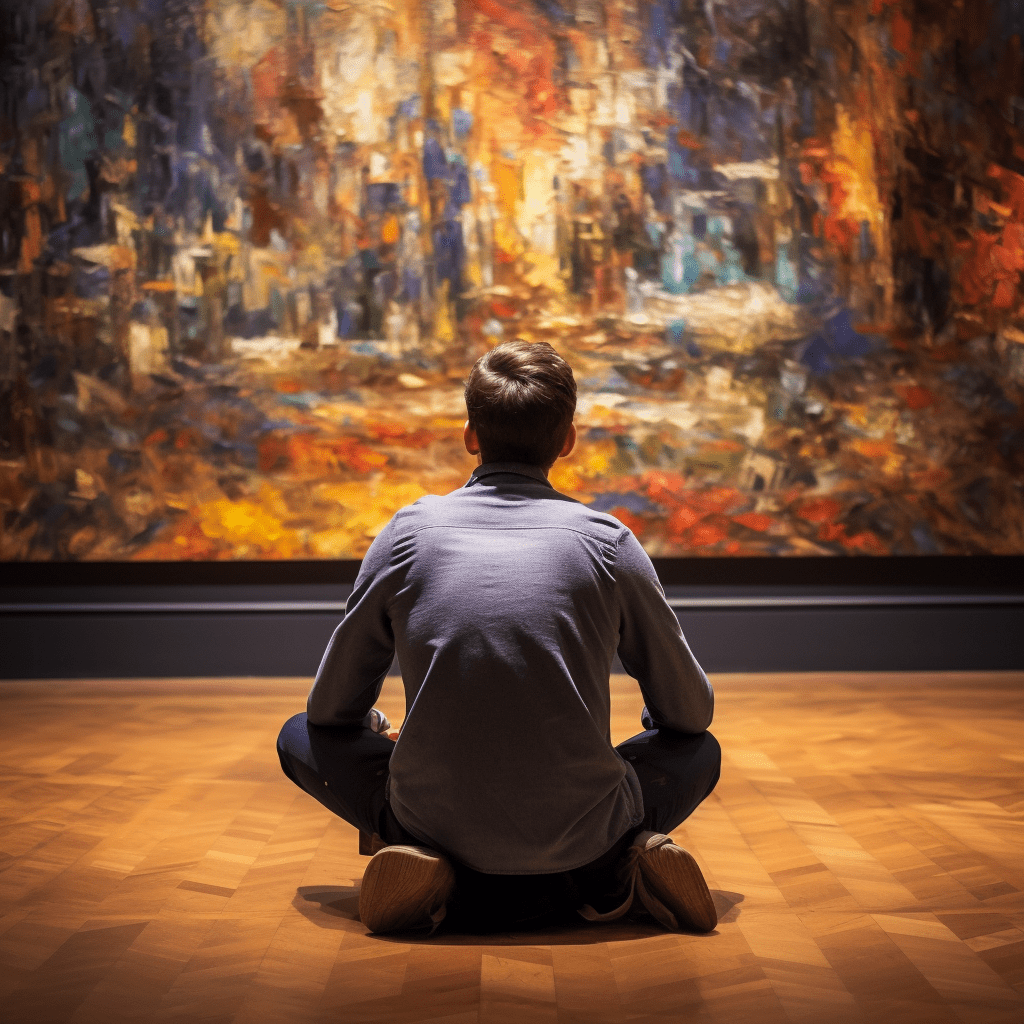In our fast-paced and constantly evolving world, it’s easy to become overwhelmed by the demands of daily life. Stress, anxiety, and a never-ending stream of distractions can leave us feeling disconnected from ourselves and our inner peace. But fear not, for there is a timeless practice that can help you find serenity and clarity amidst the chaos – Contemplation.
Contemplation is not a new-age fad; it’s an ancient practice embraced for centuries by cultures and spiritual traditions worldwide. This book will introduce you to the art and science of Contemplation, guiding you through its history, benefits, and practical techniques.
Table of Contents
Introduction to Contemplation
In this opening chapter, we will explore the fundamental concept of Contemplation. What is Contemplation, and why is it relevant in today’s world? We’ll delve into the essence of this practice and lay the foundation for your contemplative journey.
Contemplation is not just a trendy buzzword; it’s a profound and timeless practice that can bring about transformative changes in your life. In this chapter, we will embark on a journey of understanding what Contemplation truly means and how it can benefit you in this modern age.
Contemplation in Action Paperback – 24 May 2006
A collection of inspirational spiritual writings taken from Richard Rohr’s “Radical Grace” newsletter, published by Rohr’s Centre for Action and Contemplation. The contributors include Paula D’Arcy, Edwina Gately, Thomas Keating and Basil Pennington. It includes up-to-date information on the Centre’s programmes, seminars, workshops and conferences, and is written by a bestselling author.
The Essence of Contemplation
At its core, Contemplation is the art of introspection and inner exploration. It’s a deliberate and focused act of observing your thoughts, feelings, and sensations without judgment. Doing so allows you to gain insight into your inner world, develop emotional intelligence, and find inner peace.
Why Contemplation Matters
In a world filled with constant distractions and information overload, taking the time to contemplate may seem like a luxury. However, in these hectic times, Contemplation becomes a necessity. Contemplation allows you to:
- Reduce Stress: By stepping away from the chaos of daily life and turning your attention inward, you can reduce stress and anxiety,
- Enhance Self-Awareness: Contemplation helps you become more aware of your thoughts and emotions, allowing you to make conscious choices,
- Improve Decision-Making: With greater clarity of mind, you can make better decisions in both your personal and professional life,
- Find Inner Peace: Contemplation provides a sanctuary of calm within, where you can find solace and rejuvenation.
The Contemplative Journey Begins
As you read through this book, you will discover various contemplative techniques and practices that can enrich your life. But before we dive into the practical aspects of Contemplation, it’s essential to understand its historical and cultural significance.
In the next chapter, we will explore the fascinating history of contemplative practices, tracing their origins and evolution through the ages. So, get ready to embark on a journey that will not only change your perspective but also change your life. Welcome to the world of Contemplation!
The History of Contemplative Practices
In this chapter, we will embark on a historical journey through the annals of time to explore the origins and evolution of contemplative practices. Understanding the rich history of Contemplation will provide you with a deeper appreciation for its enduring relevance in our modern lives.
Contemplation, often referred to as a journey inward, has a history as vast and diverse as the human experience itself. Its roots stretch across continents and cultures, with each tradition adding a unique flavour to this timeless practice.
Ancient Beginnings
The earliest traces of contemplative practices can be found in the ancient civilisations of India, China, and Greece. In India, the yogis developed profound meditation techniques, seeking union with the divine through deep introspection. Chinese Taoists explored the inner dimensions of life, while Greek philosophers like Plato and Aristotle pondered the mysteries of existence.

The Mystics and Monastics
As civilisations evolved, so did Contemplation. The mystics of various religious traditions, such as Christianity, Islam, and Buddhism, began to emphasise the importance of direct personal experience with the divine. Monastic communities, such as those in the Christian tradition, cultivated contemplative practices to draw closer to God.
The Renaissance and Enlightenment
During Europe’s Renaissance and Enlightenment periods, Contemplation took on new dimensions. Philosophers like Descartes and Spinoza explored the power of reason and introspection to understand the self and the world. The Enlightenment championed the idea that individuals could use reason and Contemplation to free themselves from ignorance and oppression.
Contemplation in the Modern World
In the 20th century, contemplative practices experienced a resurgence in popularity, thanks partly to figures like Thich Nhat Hanh Jon Kabat-Zinn and the widespread adoption of mindfulness meditation. These practices were no longer confined to monastic settings but became accessible to people from all walks of life.
The Universal Appeal of Contemplation
Its ability to adapt and resonate with the ever-changing human experience makes Contemplation enduring and universal. Individuals from all cultural, religious and philosophical backgrounds have found solace, wisdom, and inner peace through contemplative practices.
As we continue our journey through this book, you will explore Contemplation’s practical techniques and applications. However, remember that you are not just learning a set of skills; you are connecting with a timeless tradition that has enriched the lives of countless individuals throughout history.
In the next chapter, we will delve into the tangible benefits of Contemplation, particularly its impact on mental health and well-being. So, discover how Contemplation can bring about positive changes in your life.
Benefits of Contemplation for Mental Health
In this chapter, we will explore the profound impact that Contemplation can have on your mental well-being. From reducing stress to enhancing emotional resilience, you’ll discover how this ancient practice can offer a sanctuary of tranquillity in the chaos of the modern world.
Maintaining good mental health is paramount in today’s fast-paced and often stressful world. Fortunately, Contemplation offers a pathway to nurturing and safeguarding your mental well-being.

Stress Reduction
One of the most immediate and tangible benefits of Contemplation is stress reduction. Setting aside time for self-reflection and mindfulness can lower your body’s cortisol levels, the stress hormone. As you become more attuned to your thoughts and emotions, you can identify sources of stress and develop healthier coping mechanisms.
Enhanced Emotional Resilience
Contemplation equips you with the tools to navigate the ups and downs of life with greater emotional resilience. By regularly engaging in practices like mindfulness meditation, you can develop the skills to observe your emotions without becoming overwhelmed by them. This heightened self-awareness empowers you to respond to challenges with composure and grace.
Improved Focus and Concentration
Maintaining focus and concentration can be a daily struggle in our hyper-connected world. Contemplative practices, such as concentration meditation, can sharpen your mental faculties. As you train your mind to stay present, you’ll find it easier to concentrate on tasks and immerse yourself fully in the present moment.
Clarity of Thought
Contemplation fosters clarity of thought. By examining your beliefs, values, and thought patterns, you can gain insight into your motivations and decision-making processes. This clarity can lead to better choices in your personal and professional life.
Emotional Regulation
Contemplation also helps with emotional regulation. It allows you to explore and understand your emotions, reducing impulsive reactions and promoting a more balanced emotional state. This newfound emotional intelligence can improve your relationships and overall quality of life.
Enhanced Self-Acceptance
Through Contemplation, you can cultivate a more profound sense of self-acceptance and develop a more compassionate relationship with yourself by acknowledging and embracing your strengths and weaknesses. This self-compassion is a cornerstone of mental well-being.
An Holistic Approach to Mental Health
It’s essential to note that Contemplation does not replace professional mental health care when needed. However, it can complement therapeutic practices and serve as a valuable tool for maintaining and promoting mental health.
As we journey through this book, you will encounter a variety of contemplative techniques and exercises designed to enhance your mental well-being. Contemplation offers a holistic approach to nurturing mental health, whether seeking relief from stress, more excellent emotional stability, or a sharper mind.
In the following chapters, we will dive into the practical aspects of contemplative practices, starting with creating your contemplative space and the art of mindful Breathing. Get ready to embark on a transformative journey within yourself.
Contemplation in Action Paperback – 24 May 2006
A collection of inspirational spiritual writings taken from Richard Rohr’s “Radical Grace” newsletter, published by Rohr’s Centre for Action and Contemplation. The contributors include Paula D’Arcy, Edwina Gately, Thomas Keating and Basil Pennington. It includes up-to-date information on the Centre’s programmes, seminars, workshops and conferences, and is written by a bestselling author.
The Science Behind Contemplation
In this chapter, we will explore the fascinating science that underpins contemplative practices. You’ll discover how these ancient techniques can bring about tangible changes in your brain and body, giving you a deeper appreciation of their effectiveness.
Contemplative practices have been revered for their profound effects on the mind and body for centuries. In recent years, scientific research has started to unravel the mechanisms behind these age-old techniques, shedding light on why they are so effective in promoting well-being.

Neuroplasticity: Rewiring the Brain
One of the most remarkable findings in contemplative science is the concept of neuroplasticity. Neuroplasticity is the brain’s ability to reorganise by forming new neural connections throughout life. Contemplative practices, such as meditation, have been shown to enhance neuroplasticity.
Regular meditation can increase the density of grey matter in regions of the brain associated with memory, learning, and self-awareness. This suggests that Contemplation can reshape your brain, making it more adaptable and resilient.
The Relaxation Response
When you engage in contemplative practices, you trigger the relaxation response, a state opposite to the stress response. The relaxation response leads to a decrease in heart rate, blood pressure, and muscle tension. It counteracts the harmful effects of chronic stress, promoting relaxation and overall well-being.
The Role of Mindfulness
Mindfulness, a central component of many contemplative practices, focuses on the present moment. Scientific studies have shown that mindfulness can reduce the default mode network (DMN) activity, a brain network associated with mind-wandering and self-referential thinking.
By quieting the DMN, mindfulness allows you to break free from rumination and unnecessary worries. This mental clarity enhances your ability to concentrate, make decisions, and experience life fully.
Emotional Regulation and the Amygdala
The amygdala, a region in the brain responsible for processing emotions, plays a crucial role in Contemplation’s effects on emotional regulation. Contemplative practices have been shown to reduce the amygdala’s reactivity to emotional stimuli. This means you can become less emotionally reactive and more emotionally resilient through regular Contemplation.
Immune System Boost
Contemplation has also been linked to improvements in immune system function. Stress weakens the immune system, which makes you more susceptible to illness. You can bolster your body’s natural defences by reducing stress through Contemplation.
Pain Perception and Tolerance
Studies have demonstrated that contemplative practices can alter the perception of pain. Meditation, in particular, has been associated with increased pain tolerance and reduced pain intensity. This is particularly helpful for individuals dealing with chronic pain conditions.
Enhanced Cognitive Function
Contemplation has been linked to improved cognitive functions such as attention, memory, and creativity. These enhancements can benefit your life, from work to personal relationships.
Setting Up Your Contemplative Space
In this chapter, we will guide you through creating your contemplative space. Your environment plays a crucial role in your meditative journey, and we’ll help you design a serene and conducive space for your practice.

Your contemplative space is where the magic of inner transformation begins. It’s the sanctuary where you can escape the hustle and bustle of daily life and instead, immerse yourself in Contemplation. Creating the right environment is essential to ensure a peaceful and focused practice. Here’s how you can set up your contemplative space:
Choose a Quiet Location
Select a quiet and relatively secluded area for your contemplative space. This could be a corner of a room, a spare bedroom, or even a cosy nook in your garden. The key is to find a place where you can minimise external distractions.
Declutter and Simplify
Keep your contemplative space free from unnecessary clutter. A clutter-free environment can help create a sense of calm and order. Consider using minimalist décor and furniture to keep the room simple and serene.
Comfortable Seating
Choose a comfortable chair or cushion for your contemplative practice. Many practitioners prefer cushions or mats on the floor for meditation, but you can also use a comfortable chair if that suits you better. The goal is to maintain an upright and alert posture.
Natural Light
Whenever possible, incorporate natural light into your contemplative space. Natural light has a soothing effect and can enhance your overall experience. If natural light is not available, consider soft, warm lighting options.
Plants and Nature Elements
Bringing nature into your contemplative space can create a harmonious atmosphere. Consider adding indoor plants, a small tabletop fountain, or natural elements like stones or seashells to connect with the serenity of the natural world.
Personal Touches
Personalise your space with meaningful items or symbols that hold significance for you. This could be a statue or image of a spiritual figure, inspirational quotes, or artwork that resonates with you. These personal touches can provide inspiration and motivation during your practice.
Sensory Elements
Engage multiple senses in your contemplative space. Soft textures, soothing scents, and calming sounds can enhance your experience. Use a cosy blanket, scented candles, or a small tabletop fountain to engage your senses.
Organisational Tools
Consider including organisational tools in your space, such as shelves, drawers, or baskets, to keep your contemplative supplies organised and easily accessible. This will help you maintain a sense of order and tranquillity in your space.
Sacred Space
Create a sacred space within your contemplative area if you have a specific spiritual or religious tradition. This can include an altar with religious or spiritual symbols, holy texts, or ritual objects.
Keep It Clean and Tidy
Regularly clean and maintain your contemplative space to ensure it remains a welcoming and peaceful haven. A clean room can help clear your mind and maintain a sense of tranquillity.
Your contemplative space is a reflection of your inner journey. By carefully curating this space, you create an environment that supports your contemplative practices and encourages self-discovery. In the following chapters, we will explore various contemplative techniques that you can incorporate into your newly created contemplative space. Get ready to embark on a transformative journey within yourself.
Breathing Techniques for Contemplation
This chapter will explore the importance of breath in Contemplation and introduce you to various breathing techniques that can deepen your practice. Your breath is a powerful tool for mindfulness and inner peace practise, and mastering it is vital to unlocking the full potential of Contemplation.

The breath is a bridge between the body and the mind, making it a central element in Contemplation. By focusing on your breath, you can cultivate mindfulness, reduce stress, and attain a state of inner calm. Let’s explore some essential breathing techniques for Contemplation:
- Diaphragmatic Breathing (Belly Breathing): Start sitting comfortably in your contemplative space. Placing one hand on your chest and the other on your abdomen, inhale deeply through your nose, allowing your stomach to rise, keeping your chest relatively still. Then, exhale slowly through your mouth, feeling your abdomen fall. Repeat this process, focusing on the rise and fall of your belly. This technique encourages relaxation and helps calm the nervous system.
- Counted Breathing: Find a comfortable sitting position and close your eyes. Inhale slowly through your nose for a count of four, then Hold your breath for a count of four. Exhale slowly through your mouth for a count of four. Pause for a count of four before starting the cycle again. The counting provides a rhythmic pattern that can anchor your attention and induce a sense of calm.
- Box Breathing: This technique is similar to counted Breathing but involves equal counts for each phase. Inhale for a count of four, hold for a count of four, exhale for a count of four, and then hold again for a count of four. Imagine tracing a square with your breath. Box breathing is excellent for achieving balance and grounding.
- Alternate Nostril Breathing (Nadi Shodhana): Sit comfortably with your spine straight. Use your right thumb to close off your right nostril and your right ring finger to close off your left nostril. Start by closing your right nostril and inhaling slowly through your left nostril. Then, close your left nostril, open your right nostril, and exhale through your right nostril. Then the other way; inhale through your right nostril, close it and exhale through your left nostril. This alternate nostril breathing technique balances energy and enhances clarity.
- Deep Breathing with visualisation: As you inhale deeply, imagine breathing in positive energy, calmness, or colour representing peace (e.g., blue or green). Visualise expelling stress, tension, or negative emotions in dark clouds or smoke as you exhale. This technique combines breath control with the power of your imagination to promote relaxation and emotional release.
- Mindful Breath Awareness: Observe your breath without attempting to change it in this technique. Sit quietly, paying attention to the sensation of your breath as it enters and leaves your body. Noticing the rise and fall of your abdomen, or chest. If your mind wanders, bring focus back to your breath. Mindful breath awareness is a foundational practice in mindfulness meditation.
Experiment with these breathing techniques in your contemplative space. Specific techniques resonate with you more than others. The key is to choose the one that feels most comfortable and effective for you. As you continue your contemplative journey, your breath will become an invaluable ally in your quest for inner peace and self-discovery.
Mindfulness Meditation
In this chapter, we will explore the practice of mindfulness meditation, one of the most widely recognised and accessible contemplative techniques. Mindfulness meditation allows you to cultivate a heightened awareness of the present moment, fostering inner peace and clarity.

Mindfulness meditation is a transformative practice that brings your attention to the here and now. It encourages you to observe your thoughts, emotions, and sensations without judgment, ultimately leading to a deeper understanding of yourself and the world around you. Let’s delve into the principles and techniques of mindfulness meditation:
Principles of Mindfulness
- Non-Judgment: In mindfulness meditation, you refrain from labelling your thoughts or experiences as good or bad. Instead, you observe them with neutrality and curiosity, recognising that they are simply passing mental phenomena.
- Present Moment Awareness: Mindfulness directs your attention to the present moment. Rather than dwelling on the past or worrying about the future, you focus on what’s happening now.
- Acceptance: Mindfulness involves acknowledging your experiences without resistance. Whether you’re feeling joy or sadness, you approach your emotions with acceptance and kindness.
Mindfulness Meditation Techniques
- Breath Awareness: Find a comfortable sitting position in your contemplative space. Close your eyes and bring your attention to your breath. Notice the sensation of your breath as it enters and then leaves your nostrils or the rise and fall of your abdomen. When your mind drifts, gently guide your focus back to your breath.
- Body Scan: Begin by sitting or lying down comfortably. Close your eyes and begin to focus your to different parts of your body, start from your toes and move upward. Notice any areas of tension or discomfort and observe them without trying to change them.
- Lovingkindness Meditation (Metta): Meditation involves sending well wishes to yourself and others. Start by silently repeating phrases like “May I be happy. May I be healthy? May I live with ease.” Then, extend these wishes to loved ones, acquaintances, and even those with conflicts.
- Walking Meditation: Walking meditation combines movement with mindfulness. Find a quiet, open space where you can walk slowly and deliberately. Pay attention to each step you take, the sensation of your feet as they touch the ground, and the rhythm of your breath. It can be a peaceful way to cultivate mindfulness while in motion.
- Sound Meditation: Sit comfortably and listen to the sounds around you. Instead of categorising sounds as pleasant or unpleasant, listen without attachment. This practice can heighten your auditory awareness and deepen your presence.
- Guided Meditations: You can also use guided meditation recordings or apps that provide verbal instructions and prompts. These are especially helpful for beginners.
Remember that mindfulness meditation is a skill that develops over time with consistent practice. Start with short sessions and gradually extend the duration as you become more comfortable. The benefits of mindfulness meditation include stress reduction, increased emotional regulation, improved Focus, and a greater sense of inner peace. As you continue your contemplative journey, mindfulness meditation is a powerful tool for self-discovery and well-being.
Lovingkindness Meditation
This chapter will explore the practice of Lovingkindness Meditation (Metta), a contemplative technique that cultivates compassion, love, and goodwill towards yourself and others. Metta meditation is a powerful way to enhance emotional well-being and foster harmonious relationships.
Lovingkindness Meditation, commonly known as Metta, is a profound contemplative practice that invites you to develop and radiate feelings of love, compassion, and goodwill towards yourself and all sentient beings. This practice has its roots in Buddhist traditions but is accessible and beneficial to people of all backgrounds.
The Core of Metta Meditation
At its heart, Metta meditation is about nurturing a deep sense of lovingkindness and empathy. It can be beneficial for:
- Self-Compassion: Metta begins with offering love and compassion to yourself. This is essential because, without self-compassion, it’s challenging to extend genuine love to others.
- Strengthening Relationships: Metta meditation can improve your relationships by cultivating empathy and understanding for others, even those with whom you may have conflicts.
- Emotional Well-Being: Regular practice of Metta can reduce anger, resentment, and hostility, replacing them with a sense of peace and connection.
The Practice of Metta Meditation
- Find a Quiet Space: Begin by sitting comfortably in your contemplative space. Close your eyes and take a few deep breaths to relax.
- Focus on Yourself: Silently repeat phrases like “May I be happy. May I be healthy? May I live with ease.” As you recite these phrases, feel the love and kindness you’re extending to yourself.
- Extend Metta to Loved Ones: After focusing on yourself, consider someone you love deeply, such as a family member or close friend. Repeat the exact phrases for them: “May [Name] be happy. May [Name] be healthy. May [Name] live with ease.”
- Expand to Neutral People: Next, think of someone you have neutral feelings towards, like a neighbour or colleague. Extend Metta to them as well, using the exact phrases.
- Embrace Difficult Relationships: Now, bring someone you have conflicts or difficulties with to mind. This can be challenging, but it’s a crucial step in the practice. Extend Metta to them, genuinely wishing them happiness and well-being.
- Extend Metta Universally: Finally, expand your lovingkindness to all beings in the world. Imagine your love radiating outwards, encompassing everyone, everywhere. Use phrases like “May all beings be happy. May all beings be healthy. May all beings live with ease.”
- Feel the Energy of Lovingkindness: Throughout the practice, focus on genuinely feeling the love, compassion, and goodwill you generate. Imagine it as a warm, glowing energy radiating from your heart.
- End with Gratitude: When you’re ready to conclude your Metta meditation, take a moment to express gratitude for the love and compassion you’ve cultivated. Open your eyes and carry this sense of lovingkindness into your daily life.
Metta meditation is a transformative practice that can profoundly impact your relationships, emotional well-being, and overall outlook on life. Regular exercise can lead to greater empathy, a kinder heart, and a more harmonious existence with those around you. As you continue your contemplative journey, Metta meditation can is a powerful tool for cultivating love and compassion within yourself and the world.
Body Scan Meditation
In this chapter, we will explore the practice of Body Scan Meditation, a contemplative technique that encourages deep relaxation and body awareness. This practice can help you release tension, reduce stress, and develop a profound connection between your mind and body.
Body Scan Meditation is a contemplative practice that guides your attention systematically through different parts of your body, allowing you to cultivate awareness, release tension, and promote relaxation. This technique is beneficial for grounding yourself in the present moment and alleviating physical and mental stress.
The Essence of Body Scan Meditation
Body Scan Meditation invites you to:
- Develop Body Awareness: By scanning your body from head to toe, you become acutely aware of any physical sensations or areas of tension.
- Release Tension: As you become aware of areas of tension, you can consciously relax those muscles and let go of stress.
- Mind-Body Connection: This practice strengthens the connection between your mind and body, fostering a deeper understanding of the physical sensations associated with your emotions and thoughts.
The Practice of Body Scan Meditation
- Find a Comfortable Position: Lie on your back in your contemplative space. You can use a yoga mat or a soft surface. Keep your legs uncrossed and your arms relaxed by your sides.
- Close Your Eyes: Gently close your eyes to reduce visual distractions.
- Focus on Your Breath: Take a few deep breaths to centre yourself. Now I
- inhale slowly through your nose and then exhale through your mouth, releasing any tension with each exhalation.
- Start at the Top: Scan your body from the top of your head. Bring your awareness to your scalp, forehead, and face. Notice any sensations, tension, or areas of relaxation in these regions.
- Move Downward: Gradually move your attention downward, systematically covering each body part. Pay attention to your neck, shoulders, arms, chest, back, abdomen, hips, and legs. Spend a few moments on each area.
- Notice Sensations: As you scan each body part, notice any sensations without judgment. These sensations could be warmth, tingling, pressure, or any other physical feeling.
- Release Tension: If you encounter areas of tension, consciously relax those muscles. Imagine the stress melting away with each breath.
- Breathe into Sensations: As you bring your attention to different body parts, imagine your breath flowing into and out of that area, bringing relaxation and vitality.
- Complete the Scan: Continue scanning down to your toes. Take your time and be thorough in your exploration.
- Full-Body Awareness: After reaching your toes, take a moment to appreciate the full-body awareness you’ve cultivated. Feel the sense of relaxation and connectedness throughout your body.
- Conclude the Practice: When ready to end your Body Scan Meditation, begin by taking a few deep breaths, gently wiggling your fingers and toes. Slowly bring yourself back to a seated or standing position.
Body Scan Meditation is a valuable tool for reducing stress, improving body awareness, and enhancing the mind-body connection. Regular practice can help you release physical and mental tension, promoting overall relaxation and well-being. As you continue your contemplative journey, this technique can become a trusted companion for grounding yourself in the present moment and nurturing a harmonious relationship between your body and mind.
Visualisation Techniques
In this chapter, we will explore the practice of visualisation Techniques, a contemplative method that uses imagination to foster inner clarity, creativity, and personal growth. Visualisation can help you manifest your goals, reduce stress, and enhance your overall well-being.

Visualisation is a contemplative practice that harnesses the creative power of your mind’s eye. You can positively influence your thoughts, emotions, and actions by vividly imagining specific scenes, scenarios, or outcomes. Visualisation is a versatile technique that can be applied to various aspects of your life, from personal development to stress reduction.
The Essence of Visualisation
Visualisation encourages you to:
- Clarify Your Goals: By picturing your desired outcomes, you gain more clarity about your goals and aspirations.
- Enhance Focus: Visualisation helps sharpen your Focus and intention, making it easier to direct your efforts towards your objectives.
- Reduce Stress: Calming and positive visualisations can reduce stress and anxiety, promoting relaxation.
- Boost Confidence: Visualisation can enhance self-confidence by mentally rehearsing success and achievement.
Basic visualisation Technique
- Find a Quiet Space: Begin by sitting or lying in a comfortable, quiet space, preferably in your contemplative area.
- Relax Your Body: Take a few deep breaths to relax and clear your mind. Close your eyes to reduce distractions.
- Choose a Focus: Decide on the specific scenario or outcome you want to visualise. It could be achieving a personal goal, experiencing a moment of serenity, or accomplishing a task efficiently.
- Engage Your Senses: Imagine the scenario as vividly as possible. Use all your senses to make the visualisation as realistic as you can. See the details, hear the sounds, feel the sensations, and even imagine any scents or tastes associated with the scene.
- Embrace Emotions: As you immerse yourself in the visualisation, pay attention to the emotions it evokes. Feel the joy, contentment, or satisfaction of the imagined scenario.
- Stay Present: If your mind wanders, gently bring your Focus back to the visualisation. Keep it as straightforward and vivid as you can.
- Visualise Success: If your visualisation involves a goal or achievement, see yourself succeeding. Imagine the steps you took to reach that point and the sense of accomplishment accompanying it.
- Complete the Visualisation: When you feel satisfied with the visualisation, take a few deep breaths and slowly open your eyes.
Advanced Visualisation Techniques
Advanced visualisation techniques involve more complex scenarios and may require additional guidance or expertise. These can include:
- Future Self visualisation: Visualise your future self, accomplishing your long-term goals and living your ideal life. This technique can provide inspiration and motivation.
- Healing visualisation: Use visualisation to facilitate physical or emotional healing by imagining your body and mind in perfect health and balance.
- Guided visualisation: Listen to guided visualisation recordings or work with a trained practitioner who can lead you through specific visualisation journeys tailored to your needs.
Visualisation is a dynamic contemplative practice that can empower you to manifest your aspirations, reduce stress, and boost your confidence. Visualisation can enhance your well-being and bring about positive change in your life, whether you use it for personal development, stress relief, or achieving specific goals. As you continue your contemplative journey, consider incorporating visualisation into your daily practice to unlock its transformative potential.
Surviving Life: Contemplations Of The Soul Paperback
Surviving Life is a practical and contemplative manual for people of all ages, and the perfect book for gifting to those who need guidance and love. Surviving Life is neutral on religion and politics. It is a book for everyone, regardless of religious or non-religious beliefs.
Gratitude Journaling
In this chapter, we will explore the practice of Gratitude Journaling, a contemplative technique that cultivates appreciation for the present moment and the positive aspects of your life. A gratitude journal can foster a more optimistic outlook, reduce stress, and enhance your overall well-being.

Gratitude Journaling is a contemplative practice that involves regularly recording what you are thankful for. This simple yet powerful technique shifts your Focus towards the positive aspects of your daily experiences, nurturing a sense of appreciation and contentment.
The Essence of Gratitude Journaling
Gratitude Journaling encourages you to:
- Cultivate Appreciation: By consciously acknowledging the things you are grateful for, you develop a deeper appreciation for the richness of your life.
- Shift Focus: Gratitude journaling shifts your Focus from what’s lacking in your life to what you already have, fostering contentment.
- Boost Mood: Regularly practising gratitude has been linked to improved mood, increased happiness, and reduced symptoms of depression.
- Reduce Stress: Reflecting on the positive aspects of your life can reduce stress and anxiety, promoting a sense of inner calm.
How to Start a Gratitude Journal
Starting a gratitude journal is a straightforward process. Here’s how you can get started:
- Select a Journal: Choose a physical journal or a digital platform like a note-taking app to record your gratitude entries.
- Set a Schedule: Determine how often you will journal. Many people find it helpful to do this daily, either in the morning or before bedtime, to establish a consistent routine.
- Reflect on Your Day: At your chosen time, sit quietly and reflect on your day. Consider the positive experiences, moments of joy, or things you are thankful for.
- Write It Down: Record your gratitude entries in your journal. Be specific and descriptive about what you’re thankful for. For example, instead of writing, “I’m grateful for my family,” you could write, “I’m grateful for the laughter and warmth shared with my family during dinner.”
- Acknowledge Challenges: It’s essential to acknowledge challenges or difficulties as well. You can include entries like, “I’m grateful for the opportunity to learn from today’s challenges.”
- Avoid Repetition: While it’s natural to be grateful for certain things repeatedly (e.g., family, health), try to diversify your entries to discover new sources of gratitude.
- Reflect on Your Entries: Review your past entries to see how your perspective and gratitude have evolved.
- Share Your Gratitude: You can keep your gratitude journal private or share your entries with trusted friends or family members. Sharing your gratitude can deepen your connections with others.
Advanced Gratitude Journaling
Advanced gratitude journaling techniques can further enhance your practice:
- Theme-Based Journaling: Dedicate specific journal entries to a particular theme, such as relationships, personal achievements, or moments of serenity.
- Gratitude Letters: Write letters of gratitude to people who have positively influenced your life. You can send these letters or keep them for your reflection.
- Visual Gratitude Journal: Incorporate visual elements like drawings, photographs, or collages into your gratitude journal to make it a creative and engaging practice.
Gratitude Journaling is a contemplative practice that can profoundly impact your outlook on life. As you continue your contemplative journey, consider incorporating this practice into your daily routine. Over time, gratitude journaling fosters a greater sense of happiness, contentment, and appreciation for the abundance in your life.
One Year of Gratitude Journaling
One Year of Gratitude Journaling is for everyone and anyone, and you can start at anytime of the year! Learn how to develop an inherent thankful disposition using this daily guide to create an Attitude of Gratitude. At the end of each week are some questions to help you even more.
Contemplative Walking
In this chapter, we will explore the practice of Contemplative Walking, a technique that combines the physical act of walking with mindfulness and self-awareness. Contemplative walking can be a powerful way to connect with the world around you and find inner peace through movement.
Contemplative walking, often called walking meditation, is a contemplative practice that blends the rhythm of walking with mindfulness and self-awareness. It allows you to engage with your surroundings deliberately and intently, fostering a deep sense of connection to the present moment.
The Essence of Contemplative Walking
Contemplative walking encourages you to:
- Ground Yourself: Walking provides a physical connection to the Earth, promoting a sense of grounding and stability.
- Cultivate Mindfulness: By paying attention to each step and breath, you can cultivate mindfulness, which enhances your awareness of the present moment.
- Find Inner Peace: Contemplative walking offers a tranquil way to calm your mind, reduce stress, and experience inner peace through movement.
- Connect with Nature: If you walk outdoors, this practice can deepen your connection to nature and the environment.
How to Practise Contemplative Walking
Follow these steps to practise contemplative walking:
- Choose Your Location: Find a quiet and safe place to walk. This can be indoors or outdoors, depending on your preference and the availability of suitable spaces.
- Set an Intention: Set an intention or focus for your practice before walking. It could be to cultivate mindfulness, release stress, or enjoy the act of walking.
- Begin Walking: Start walking at a comfortable pace. You can walk in a straight line or a circle, whichever suits your location.
- Focus on Your Breath: Pay attention to your breath as you walk. Coordinate your breath with your steps, taking one step with each inhale, and one step with each exhale.
- Observe Sensations: As you walk, notice the sensation of your feet lifting off the ground, moving through the air, and making contact with the surface again. Be fully present in each step.
- Mindful Movement: If your mind starts to wander, gently bring your Focus back to the sensation of walking. Notice how your body moves with each step, the shifting of your weight, and the rhythm of your breath.
- Engage Your Senses: If you’re outdoors, engage your senses by observing the sights, sounds, and scents around you. Feel the sun or breeze on your skin, hear the rustling of leaves, or smell the fragrance of flowers.
- Set a Duration: You can practise contemplative walking for a specific duration, such as 10 or 20 minutes, or walk until you feel a sense of calm and connection.
- Conclude Mindfully: When you conclude your contemplative walk, stand still momentarily and take a few deep breaths. Acknowledge the practice and the sense of presence it brought you.
Advanced Contemplative Walking
For advanced practitioners, consider the following variations:
- Walking in Nature: Practice contemplative walking in natural settings like forests, parks, or near bodies of water to deepen your connection with the environment.
- Walking Mantras: Recite a mantra or affirmations silently as you walk. This can add a meditative dimension to your practice.
- Walking with Gratitude: Use your contemplative walk to express gratitude for the natural world and your ability to move.
Contemplative walking is a versatile and accessible practice that can be adapted to suit your needs and environment. Whether seeking a mindful way to move your body or a serene connection with nature, this practice can provide a unique pathway to inner peace and self-awareness. As you continue your contemplative journey, consider incorporating meditative walking into your routine to experience its many benefits.
Contemplative Art and Creativity
In this chapter, we will explore the practice of Contemplative Art and Creativity, a technique that taps into your creative expression as a means of Contemplation and self-discovery. Engaging in creative activities can be a profoundly contemplative experience that deepens your understanding of yourself and the world.
Contemplative art and creativity encompass various artistic practices, including visual arts, writing, music, dance, and more. This contemplative technique invites you to harness your creative energy as a means of self-expression, exploration, and inner reflection.

The Essence of Contemplative Art and Creativity
Contemplative art and creativity encourage you to:
- Express Your Inner World: Artistic expression provides a powerful outlet for conveying emotions, thoughts, and experiences that may be challenging to put into words.
- Discover Insights: Creating art can lead to insights and revelations about yourself, your beliefs, and your world perception.
- Enhance Mindfulness: Engaging in creative activities can cultivate mindfulness by anchoring your Focus in the present moment.
- Promote Emotional Healing: Art and creativity can be a therapeutic tool for processing emotions and healing from past traumas.
How to Practise Contemplative Art and Creativity
You can engage in contemplative art and creativity using various mediums and techniques. Here’s an essential guide to get started:
- Choose Your Medium: Select an artistic medium or creative activity that resonates with you. This could be painting, drawing, writing, playing a musical instrument, dancing, sculpting, or any other creative expression.
- Create a Contemplative Space: Set up a dedicated space for your chosen creative activity. Ensure it is a quiet and inspiring environment.
- Set an Intention: Before you begin, set an intention for your creative practice. What do you hope to explore, express, or discover through your art?
- Enter a Meditative State: As you start creating, focus on the process rather than the outcome. Allow your thoughts to flow freely without judgement. Engage your senses in the act of creation.
- Embrace the Flow: Let your creativity flow naturally. Trust your intuition and instincts. Allow your art to evolve organically.
- Reflect and Explore: Reflect on your work after completing your creative session. Consider what it reveals about your thoughts, feelings, or experiences. Explore the symbolism and meaning behind your creation.
- Express Through Words: You can enhance the contemplative aspect by journaling about your creative process. Write down your thoughts and insights as you engage in your creative activity.
- Continue the Practice: Make contemplative art and creativity a regular practice. It may be daily, weekly, or as often as you find meaningful. Over time, your creative journey can become a valuable tool for self-discovery and personal growth.
Advanced Contemplative Art and Creativity
Advanced practitioners of contemplative art and creativity may explore the following:
- Collaborative Projects: Engage in collaborative art projects to discover different perspectives and insights.
- Art Therapy: Consider working with an art therapist who can guide you in using art for emotional healing and self-exploration.
- Explorative Challenges: Push your creative boundaries by setting challenges or limitations for your artistic practice. For example, create art using only one colour or write a story within a strict word count.
Contemplative art and creativity offer a profound way to engage with your inner world, foster self-expression, and tap into your creative potential. As you continue your contemplative journey, consider how incorporating artistic practices can deepen your understanding of yourself and the world around you.
Contemplative Relationships
In this chapter, we will explore the practice of Contemplative Relationships, a technique that focuses on cultivating mindfulness and awareness within your interactions with others. Contemplative relationships can lead to deeper connections, improved communication, and enhanced empathy.
Contemplative relationships involve applying mindfulness and self-awareness to your interactions with others. This practice emphasises being fully present and attentive when communicating with friends, family, colleagues, and strangers.

The Essence of Contemplative Relationships
Contemplative relationships encourage you to:
- Cultivate Presence: By being fully present in your interactions, you can establish a deeper connection with others.
- Enhance Communication: Mindful listening and speaking can lead to more transparent, more effective communication.
- Empathise: Contemplative relationships foster empathy by allowing you to better understand the perspectives and feelings of others.
- Resolve Conflicts: Practising mindfulness in challenging conversations can help you respond thoughtfully rather than reactively, facilitating conflict resolution.
How to Practise Contemplative Relationships
Engaging in contemplative relationships involves the following steps:
- Set an Intention: Before any interaction, set an intention to be fully present and mindful during the conversation. Remind yourself to listen actively and without judgment.
- Practise Mindful Listening: Give them your full attention when the other person speaks. Maintain eye contact, avoid interrupting, and resist the urge to formulate your response while they’re saying.
- Observe Your Reactions: Be aware of your emotional reactions during the conversation. Notice any tendencies to become defensive, judgmental, or impatient. These observations can help you respond more skillfully.
- Empathise: Try to see the situation from the other person’s perspective. Ask open-ended questions to gain a better understanding of their feelings and thoughts.
- Pause and Reflect: Before responding, take a moment to pause and reflect. Consider the impact of your words and whether they align with your intention of fostering a contemplative relationship.
- Express Yourself Mindfully: Do so mindfully when it’s your turn to speak. Choose your words carefully and express yourself honestly and respectfully.
- Seek Common Ground: Look for common ground or shared values in disagreements or conflicts. This can help bridge differences and facilitate understanding.
- Practice Gratitude: Express gratitude and appreciation for the people in your life. Small gestures of kindness can strengthen relationships.
- Learn from Every Interaction: After each interaction, reflect on what you learned about yourself and the other person. Consider how you can continue to improve your contemplative relationship skills.
Advanced Contemplative Relationships
For advanced practitioners, consider the following:
- Mindful Relationship Retreats: Attend relationship-focused retreats or workshops providing in-depth contemplative relationship training.
- Conflict Resolution Training: Learn and apply specific techniques for resolving conflicts mindfully and compassionately.
- Meditation for Lovingkindness: Incorporate lovingkindness meditation into your daily practice to enhance your capacity for empathy and compassion.
Contemplative relationships are a powerful way to deepen your connections with others, improve your communication skills, and enhance your capacity for empathy. As you continue your contemplative journey, consider how these practices can enrich your personal and professional relationships, fostering greater understanding, harmony, and well-being.
Contemplative Living
In this final chapter, we will explore the practice of Contemplative Living, which integrates mindfulness and self-awareness into your daily life. Contemplative living invites you to embrace each moment with intention, leading to a more meaningful and fulfilling existence.
Contemplative living is a holistic approach to integrating mindfulness and self-awareness into every aspect of your daily life. It invites you to be fully present in each moment, whether you’re working, eating, conversing, or simply being. Contemplative living extends the benefits of mindfulness beyond formal practice sessions and into your entire existence.
The Essence of Contemplative Living
Contemplative living encourages you to:
- Embrace Mindfulness: Infuse every moment with mindfulness, whether you’re engaged in routine tasks or significant life events.
- Live with Intention: Approach each day with intention and purpose, aligning your actions with your values and aspirations.
- Savour Life’s Moments: Recognise the beauty and significance of the small moments that make up your life, such as a sunrise, a shared meal, or a quiet moment of reflection.
- Cultivate Gratitude: Develop a deep gratitude for your life’s opportunities, experiences, and relationships.
How to Practise Contemplative Living
Practising contemplative living is a continuous and evolving journey. Here are some steps to help you get started:
- Set Daily Intentions: Begin each day by setting intentions for how you want to approach your tasks, interactions, and challenges. These intentions can serve as a guiding compass throughout the day.
- Practise Mindful Presence: Be present in your daily activities, whether eating, walking, working, or spending time with loved ones. Bring your full attention to each moment.
- Pause and Breathe: Incorporate mini-mindfulness breaks into your day. Pause for a few deep breaths and centre yourself whenever you feel stressed or overwhelmed.
- Reflect on Your Actions: At the end of each day, take a few moments to reflect on your actions, interactions, and reactions. Consider how you can align your behaviour with your values.
- Cultivate Gratitude: Keep a gratitude journal or take a moment each day to express gratitude for the people, experiences, and opportunities in your life.
- Embrace Simplicity: Simplify your life by decluttering your physical space and minimising distractions. This can create a sense of calm and clarity.
- Connect with Nature: Spend time in nature regularly to reconnect with the natural world and experience a sense of awe and wonder.
Advanced Contemplative Living
For advanced practitioners of contemplative living, consider these additional practices:
- Deepen Formal Meditation: Dedicate more time to formal meditation practice to strengthen your mindfulness skills.
- Mindful Consumption: Be aware of what you consume, whether it’s food, media, or information. Choose content and experiences that align with your values.
- Service and Compassion: Integrate acts of kindness and compassion into your daily life by helping others and contributing to your community.
- Silent Retreats: Participate in silent retreats to deepen your contemplative practice and experience extended periods of mindful living.
Contemplative living is a lifelong journey that can profoundly transform your life experience. It’s about embracing each moment with intention, gratitude, and awareness. As you continue your contemplative journey, contemplate how these practices can enrich your daily life, leading to a more meaningful and fulfilling existence.
Conclusion: The Path of Contemplation
In this comprehensive guide, we’ve embarked on a journey through the world of Contemplation, exploring various contemplative practices that can enrich your life and deepen your connection to yourself and the world around you.

From the foundational principles of mindfulness to the advanced techniques of contemplative living, you’ve discovered a wide array of practices that can empower you to:
- Cultivate a deep sense of self-awareness and presence.
- Manage stress and enhance your emotional well-being.
- Foster empathy, compassion, and lovingkindness.
- Tap into your creative potential and self-expression.
- Strengthen your relationships and communication skills.
- Live a more intentional and purposeful life.
Contemplation is not a destination but a lifelong journey. It’s about exploring your inner world and your connection to the outer world. As you continue on this path, remember that each moment, each breath, and each interaction can be an opportunity for Contemplation.
Embrace the practices that resonate with you, and adapt them to your unique journey. There is no one-size-fits-all approach to Contemplation, and your path may evolve. The key is approaching this journey with an open heart and a curious mind, ready to explore the depths of your consciousness and the richness of your existence.
As you navigate the challenges and joys of life, may the wisdom and insights gained through Contemplation serve as your compass, guiding you towards a life filled with meaning, purpose, and inner peace.
May your contemplative journey be a source of continuous growth, transformation, and deep connection to yourself and the world.
With mindfulness and Contemplation, you have the power to create a life of profound meaning and fulfilment.
Bon voyage on your contemplative journey.
Appendix: Resources for Your Contemplative Journey
As you embark on your contemplative journey, it’s valuable to have access to resources that can support and enrich your practice. Here, we provide a list of recommended resources to help you dive deeper into the world of Contemplation:
“The Miracle of Mindfulness” by Thich Nhat Hanh
Buddhist monk and Nobel Peace Prize nominee Thich Nhat Hanh explains how to acquire the skills of mindfulness. Once we have these skills, we can slow our lives down and discover how to live in the moment – even simple acts like washing the dishes or drinking a cup of tea may be transformed into acts of meditation.
- Books on Mindfulness and Contemplation:
- “The Miracle of Mindfulness” by Thich Nhat Hanh
- “Wherever You Go, There You Are” by Jon Kabat-Zinn
- “The Power of Now” by Eckhart Tolle
- “Radical Acceptance” by Tara Brach
- “A Path with Heart” by Jack Kornfield
- Guided Meditation Apps:
- Insight Timer
- Headspace
- Calm
- 10% Happier
- Buddhify
- Online Courses and Programs:
- Mindfulness-Based Stress Reduction (MBSR) programs
- Online courses on mindfulness and meditation platforms
- Contemplative Retreats:
- Consider attending residential or virtual contemplative retreats led by experienced teachers. Many spiritual and meditation centres offer retreats throughout the year.
- Local Contemplative Communities:
- Explore your area’s local meditation groups, yoga studios, and mindfulness centres. Joining a community can provide valuable support and connection.
- Online Contemplative Communities:
- Participate in online forums, discussion groups, or social media communities focused on Contemplation and mindfulness. These platforms can connect you with like-minded individuals and resources.
- Mindfulness and Contemplative Practitioners:
- Seek guidance and teachings from experienced mindfulness and contemplative practitioners. They can offer personalised insights and support.
- Contemplative Journals and Tools:
- Consider keeping a contemplative journal to record your insights and reflections. Various journaling tools and templates are available to facilitate your practice.
- Contemplative Art Supplies:
- If you’re interested in contemplative art and creativity, gather the necessary art supplies for your chosen medium, drawing, painting, writing, or music.
- Mindful Living Books:
- Explore books on mindful living, which offer practical insights on incorporating mindfulness into everyday activities, such as eating, walking, and working.
- Contemplative Websites and Blogs:
- Numerous websites and blogs are dedicated to contemplation, mindfulness, and related practices. These can provide articles, guided meditations, and inspiration.
- Professional Guidance:
- Consider working with mindfulness coaches, therapists, or meditation instructors who can offer personalised guidance and support tailored to your needs.
Remember that your contemplative journey is unique, and choosing resources and practices that resonate with you is essential. Continuously explore, learn, and adapt your approach as you deepen your contemplative practice and embrace a life enriched by mindfulness, presence, and inner wisdom.
May your contemplative journey be filled with profound insights, inner peace, and a deep connection to the beauty and wonder of life.
Acknowledgements
Embarking on a contemplative journey is a transformative experience, and it’s essential to recognise the contributions and support of those who have been part of your path. In this section, we acknowledge the people and elements that have played a significant role in your contemplative journey:
- Teachers and Mentors: Express gratitude to the teachers, mentors, and guides who have shared their wisdom, teachings, and insights with you. Their guidance has been invaluable in shaping your contemplative practice.
- Family and Friends: Acknowledge your family and friends’ understanding, patience, and encouragement. Their support has created a nurturing environment for your contemplative journey.
- Contemplative Communities: Thank the communities and groups of like-minded individuals who have provided a sense of belonging, camaraderie, and shared learning throughout your journey.
- Nature and the Universe: Recognise the beauty and wonder of the natural world, which has been a source of inspiration, solace, and connection during your contemplative moments.
- Inner Self: Acknowledge your dedication, curiosity, and courage in embracing the contemplative path. Your commitment to self-discovery and personal growth has been the driving force behind your journey.
- Challenges and Lessons: Embrace the challenges, obstacles, and difficult moments that have been integral to your contemplative journey. They have been your teachers, offering profound lessons and opportunities for growth.
- Books and Resources: Show appreciation for the books, resources, and tools that have enriched your practice and expanded your understanding of Contemplation.
- Moments of Stillness: Recognise the moments of stillness, silence, and solitude that have allowed you to dive deep into your contemplative practice and connect with your inner self.
- Life’s Miracles: Celebrate the serendipitous events, synchronicities, and moments of awe and wonder illuminating your path and reinforcing your sense of purpose.
- The Present Moment: Finally, express gratitude for the present moment itself. In this very moment, your contemplative journey unfolds, offering boundless opportunities for growth, self-discovery, and connection to the profound beauty of existence.
As you acknowledge these elements and individuals, you honour the interconnectedness of your contemplative journey with the world around you. May this practice of gratitude deepen your appreciation for the richness of life and inspire you to continue your contemplative journey with an open heart and a spirit of curiosity and wonder.
References and Further Reading
- Kabat-Zinn, J. (1994). “Wherever You Go, There You Are: Mindfulness Meditation in Everyday Life.” Hyperion.
- Brach, T. (2004). “Radical Acceptance: Embracing Your Life With the Heart of a Buddha.” Bantam.
- Tolle, E. (1999). “The Power of Now: A Guide to Spiritual Enlightenment.” New World Library.
- Kornfield, J. (2001). “A Path with Heart: A Guide Through the Perils and Promises of Spiritual Life.” Bantam.
- Nhat Hanh, T. (1999). “The Miracle of Mindfulness: An Introduction to Meditation Practice.” Beacon Press.
- Kabat-Zinn, J. (2005). “Coming to Our Senses: Healing Ourselves and the World Through Mindfulness.” Hyperion.
- Goldstein, J., & Kornfield, J. (1998). “Seeking the Heart of Wisdom: The Path of Insight Meditation.” Shambhala.
- Chödrön, P. (1994). “The Places That Scare You: A Guide to Fearlessness in Difficult Times.” Shambhala.
- Salzberg, S. (1995). “Lovingkindness: The Revolutionary Art of Happiness.” Shambhala.
- Germer, C. K. (2009). “The Mindful Path to Self-Compassion: Freeing Yourself from Destructive Thoughts and Emotions.” Guilford Press.
These references offer a wealth of information and guidance on contemplation, mindfulness, and related practices. Exploring these books and resources can further deepen your understanding and provide valuable insights as you continue your contemplative journey.
Author’s Note
As we conclude this exploration of Contemplation, mindfulness, and the practices that enrich our lives, I want to extend my heartfelt appreciation for joining me on this journey. The world of Contemplation is vast and profound, offering endless opportunities for self-discovery, personal growth, and connection to the beauty of existence.
Whether you are just beginning your contemplative journey or have been walking this path for some time, remember that every step is valuable. Embrace the present moment with curiosity and openness, for it is now that we find the Essence of Contemplation.
May your practice of Contemplation continue to illuminate your inner world, foster deep connections with others, and lead you to a life of purpose, meaning, and inner peace.
Stay Connected:
We’re here for you every step of the way. Whether you have questions, breakthroughs to share, or stories of your own, we welcome you to stay connected with us.
Join our community, reach out, and let us celebrate your victories and support your challenges.
Affiliate Declaration
This post contains affiliate links. If you click on one of these links and make a purchase, I may receive a commission. You may also benefit from some links as you may receive a discount or free trial on some links.









